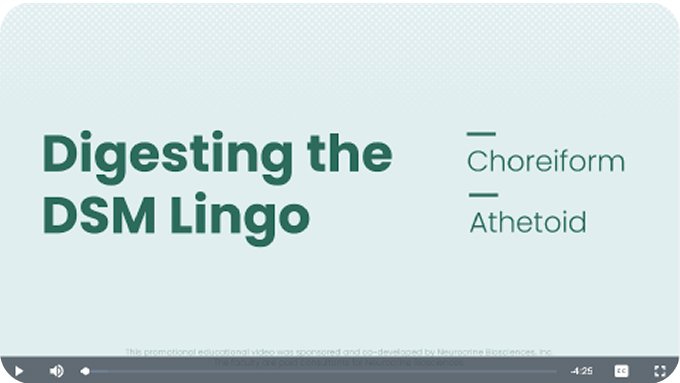

~4 mins
•Jan 2025
Digesting the DSM Lingo


Actor portrayals.
Tardive dyskinesia (TD) is a chronic drug-induced movement disorder characterized by involuntary movements in the body or face.1-4 It is prevalent, with estimates indicating that at least 800,000 individuals in the United States have TD.5 Patients who have taken a dopamine receptor blocking agent (DRBA), such as antipsychotics and some antiemetics, may be at risk.2,6,7 The involuntary movements of TD, even if mild in severity, can have a large impact on patients’ physical and psychological well-being.8-10
Once a diagnosis is made, treatment can significantly reduce symptoms.3,11
Explore our comprehensive database of expert-led educational resources. This includes journal reviews, podcasts, investigative presentations, and video case studies developed to support prompt screening and diagnosis of TD, as well as guideline-supported treatment approaches. Search based on your learning needs or format preferences.
Now learn to identify TD in your patients
DIMD Course
Take the Drug-Induced Movement Disorders (DIMD) Course, sponsored and developed by Neurocrine Biosciences, Inc., for practice recognizing and differentiating DIMDs and a review of treatment guideline recommendations.
Discover TD
Test your differential diagnosis skills in this interactive, educational experience. You’ll learn and practice with virtual patients, evaluate their symptoms, and determine whether they’re associated with TD or drug-induced parkinsonism.
References
Savitt D, Jankovic J. J Neurol Sci. 2018;389:35-42.
Fahn S, et al, eds. Principles and Practice of Movement Disorders. 2nd ed. Saunders; 2011:415-446.
Meyer JM. In: Brunton LL, et al, eds. Goodman & Gilman's: The Pharmacological Basis of Therapeutics. 13th ed. McGraw-Hill; 2018.
American Psychiatric Association. Diagnostic and Statistical Manual of Mental Disorders. 5th ed., text rev. American Psychiatric Association; 2022.
Data on file.
Hauser RA, et al. CNS Spectr. 2022;27(2):208-217.
Yohanna D, et al. JAMA. 2017;318(11):1057-1058.
Jain R, et al. J Clin Psychiatry. 2023;84(3):22m14694.
Tanner CM, et al. J Patient Rep Outcomes. 2023;7(1):21.
McEvoy J, et al. Qual Life Res. 2019;28(12):3303-3312.
American Psychiatric Association. The American Psychiatric Association Practice Guideline for the Treatment of Patients With Schizophrenia. 3rd ed. American Psychiatric Association; 2021.